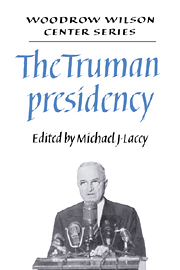Book contents
- Frontmatter
- Contents
- Acknowledgments
- Introduction and summary: The Truman era in retrospect
- 1 The mind and character of Harry S. Truman
- Part I Domestic politics and issues
- Part II Foreign policy and national defense
- 7 The national security state reconsidered: Truman and economic containment, 1945–1950
- 8 The insecurities of victory: the United States and the perception of the Soviet threat after World War II
- 9 Alliance and autonomy: European identity and U.S. foreign policy objectives in the Truman years
- 10 U.S. policy in the Near East: the triumphs and tribulations of the Truman administration
- 11 Toward a post-colonial order: Truman administration policies toward South and Southeast Asia
- 12 Occupied Japan and the cold war in Asia
- 13 The Truman administration and the Korean War
- About the authors
- Index
13 - The Truman administration and the Korean War
Published online by Cambridge University Press: 06 October 2009
- Frontmatter
- Contents
- Acknowledgments
- Introduction and summary: The Truman era in retrospect
- 1 The mind and character of Harry S. Truman
- Part I Domestic politics and issues
- Part II Foreign policy and national defense
- 7 The national security state reconsidered: Truman and economic containment, 1945–1950
- 8 The insecurities of victory: the United States and the perception of the Soviet threat after World War II
- 9 Alliance and autonomy: European identity and U.S. foreign policy objectives in the Truman years
- 10 U.S. policy in the Near East: the triumphs and tribulations of the Truman administration
- 11 Toward a post-colonial order: Truman administration policies toward South and Southeast Asia
- 12 Occupied Japan and the cold war in Asia
- 13 The Truman administration and the Korean War
- About the authors
- Index
Summary
In his January 1953 farewell address, President Harry S. Truman cited his many momentous decisions, including dropping the atomic bomb on Japan; applying containment through the Truman Doctrine, Marshall Plan, and NATO to “save” Europe; integrating Japan and West Germany into a United States-led international system; and expanding military budgets and foreign military aid. “Most important of all,” he declared, “we acted in Korea.” The administration's commitment of U.S. troops to that war “established to the Kremlin,” he contended, “the determination of free peoples to defend themselves.”.
The Korean War erupted openly on 25 June 1950, when the North Korean forces attacked South Korea on the recently divided peninsula. That invasion, following a few years of insurrections in South Korea and border incursions by both North and South Korea, propelled the Truman administration during the next five days to intervene in what was basically an ongoing revolution and civil war.
Despite some Republican criticism, Truman refused to seek a declaration of war and soon labeled this military intervention a “police action.” But he did want international legitimation, and thus his government gained United Nations (UN) Security Council resolutions (with the Soviet Union absent) declaring the North Korean attack a “breach of the peace,” calling on nations “to help repel the armed attack,” and creating a U.S.-directed UN command.
- Type
- Chapter
- Information
- The Truman Presidency , pp. 410 - 444Publisher: Cambridge University PressPrint publication year: 1989
- 3
- Cited by



